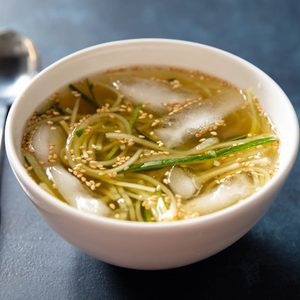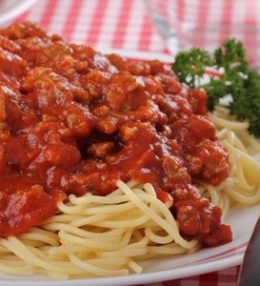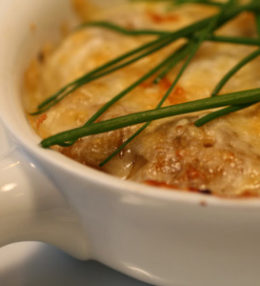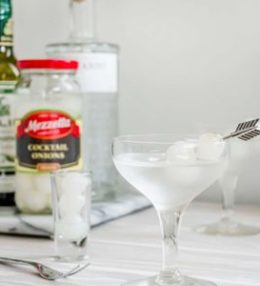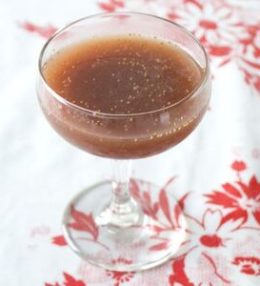
Why It Works
- Korean and English cucumbers have a thinner skin and higher ratio of flesh to seeds, which works well for the matchstick-thin strips needed here.
- Traditional Korean Joseon 100% soy sauce adds a salty, savory flavor, without the sweetness of soy-and-wheat-based yangjo soy sauce.
Summer weather in Korea isn’t just hot; it’s also incredibly humid, thanks to our summer monsoons. We like to cool down with ice-cold dishes, both sweet and savory. One of the easiest to make is oi naengguk (오이 냉국), a beloved cold cucumber soup. Back in our parents’ generation, before we had air conditioning, it was an icy snacktime treat for people working under the sizzling sun out in the fields—they’d drink it down like water.
These days, recipes for oi naengguk have gotten sweeter and sweeter, but from what I remember, my grandmother added only Joseon ganjang (traditional soy sauce) to the thinly shredded cucumber and water. Simple and delicious.
A few tips for making oi (“cucumber”) naengguk (“cold soup”): First, if you’re in the States and can’t get Korean cucumbers, try to use English cucumbers or other thin-skinned varieties. Avoid the fat, waxed cucumbers from the supermarket; their skin is too heavy and waxy, and they have an excess of seeds that don’t work well in the soup. Use a mandoline for more evenly sized pieces of cucumber (if you’re in the market for one, read Serious Eats’ mandoline review).
When choosing a soy sauce, opt for Joseon ganjang, which is the more traditional Korean style made with soybeans only. It’s sometimes also called “soup soy sauce,” and it has a saltier, more savory, and more assertive flavor than the sweeter, Japanese-influenced yangjo ganjang, which also contains wheat. (Read more on Korean soy sauces and other pantry staples in our guide to essential Korean ingredients.)
If you can find it, try to use a cheongjang, or young, artisanal soy sauce with a lighter color. An older soy sauce will give you a much darker liquid base—in which case, you can use less soy sauce and more salt and ice, though you’ll miss out on some of that nice umami flavor.
Serious Eats / Vicky Wasik
The basic recipe for oi naengguk that I’m giving here (linked at the top and bottom of the page) contains very few ingredients: just cucumber, water (and ice), soy sauce, garlic, vinegar, salt, and roasted sesame seeds. There are lots of ways to change it up, though.
One common variation on oi naengguk uses miyeok, a seaweed often sold in the States under its Japanese name, wakame. For this option, soak 10 grams of dried miyeok in water for about 30 minutes.
Ten grams may not seem like much, but it is—when soaked, miyeok will increase about 10 times in weight and volume! That means you’ll end up with about 100 grams of rehydrated miyeok, which will be more than enough to add to my base recipe. After soaking the miyeok, blanch, rinse, and squeeze it out before adding it to your soup.
You can also add thinly sliced and rinsed white onion and julienned carrot. And, while it’s not traditional, I think some julienned apple for a little extra sweetness is nice, too. If you’re adding apple, serve the soup right away, so the apple doesn’t sit around and turn brown.
Serve it in soup bowls, and don’t be afraid to pick up your bowl and drink it down—it’s a terrifically refreshing antidote to the sweltering summer weather.
August 2019
Icy-Cold Korean Cucumber Soup (Oi Naengguk) Recipe
-
One 1-pound (500g) cucumber, preferably Korean or English (about 8 to 10 inches/20 to 25cm long; see note)
-
4 medium cloves garlic, finely minced
-
2 1/4 cups (500ml) cold water
-
2 tablespoons (30ml) Joseon ganjang (Korean soup soy sauce; see note)
-
2 tablespoons (30ml) Korean yangjo vinegar (brown rice vinegar; see note)
-
Kosher salt
-
18 ounces ice cubes (500g; the equivalent of 2 1/4 cups/500ml water frozen into cubes)
-
1 teaspoon roasted sesame seeds
-
Cut cucumber into roughly 4-inch (10cm) lengths. Using a knife or mandoline, julienne the cucumber as finely as you can.
-
In a large mixing bowl, combine cucumber with garlic, water, soy sauce, and vinegar, stirring to distribute ingredients. Season with salt. Transfer to refrigerator if not serving right away.
Serious Eats / Vicky Wasik
-
When ready to serve, add ice cubes and season once more with salt, if needed. Sprinkle sesame seeds on top. Ladle into individual bowls, along with the ice cubes, and serve.
Serious Eats / Vicky Wasik
Special Equipment
Mandoline
Notes
Standard, waxy American cucumbers have a skin that’s too thick and heavy, as well as an overabundance of seeds; they’re best avoided here.
See our guide to the Korean pantry for more on Joseon ganjang and yangjo vinegar, including brand recommendations.
Make-Ahead and Storage
The julienned cucumber, garlic, water, soy sauce, and vinegar can be combined, seasoned with salt, and kept refrigerated up to 4 hours before the ice is added and the soup is served.
Read More
- Mul Naengmyun (Cold Korean Noodle Soup) Recipe
- Our Favorite Cold Soup Recipes for Hot, Hot Weather
- An Introduction to the Spicy, Funky World of Korean Soups and Stews
- How to Stock a Korean Pantry
- How to Eat Korean Food (Without Embarrassing Yourself)
Why It Works Korean and English cucumbers have a thinner skin and higher ratio of flesh to seeds, which works well for the matchstick-thin strips needed here.Traditional Korean Joseon 100% soy sauce adds a salty, savory flavor, without the sweetness of soy-and-wheat-based yangjo soy sauce. Summer weather in Korea isn’t just hot; it’s also incredibly humid, thanks to our summer monsoons. We like to cool down with ice-cold dishes, both sweet and savory. One of the easiest to make is oi naengguk (오이 냉국), a beloved cold cucumber soup. Back in our parents’ generation, before we had air conditioning, it was an icy snacktime treat for people working under the sizzling sun out in the fields—they’d drink it down like water. These days, recipes for oi naengguk have gotten sweeter and sweeter, but from what I remember, my grandmother added only Joseon ganjang (traditional soy sauce) to the thinly shredded cucumber and water. Simple and delicious. A few tips for making oi (“cucumber”) naengguk (“cold soup”): First, if you’re in the States and can’t get Korean cucumbers, try to use English cucumbers or other thin-skinned varieties. Avoid the fat, waxed cucumbers from the supermarket; their skin is too heavy and waxy, and they have an excess of seeds that don’t work well in the soup. Use a mandoline for more evenly sized pieces of cucumber (if you’re in the market for one, read Serious Eats’ mandoline review). When choosing a soy sauce, opt for Joseon ganjang, which is the more traditional Korean style made with soybeans only. It’s sometimes also called “soup soy sauce,” and it has a saltier, more savory, and more assertive flavor than the sweeter, Japanese-influenced yangjo ganjang, which also contains wheat. (Read more on Korean soy sauces and other pantry staples in our guide to essential Korean ingredients.) If you can find it, try to use a cheongjang, or young, artisanal soy sauce with a lighter color. An older soy sauce will give you a much darker liquid base—in which case, you can use less soy sauce and more salt and ice, though you’ll miss out on some of that nice umami flavor. Serious Eats / Vicky Wasik The basic recipe for oi naengguk that I’m giving here (linked at the top and bottom of the page) contains very few ingredients: just cucumber, water (and ice), soy sauce, garlic, vinegar, salt, and roasted sesame seeds. There are lots of ways to change it up, though. One common variation on oi naengguk uses miyeok, a seaweed often sold in the States under its Japanese name, wakame. For this option, soak 10 grams of dried miyeok in water for about 30 minutes. Ten grams may not seem like much, but it is—when soaked, miyeok will increase about 10 times in weight and volume! That means you’ll end up with about 100 grams of rehydrated miyeok, which will be more than enough to add to my base recipe. After soaking the miyeok, blanch, rinse, and squeeze it out before adding it to your soup. You can also add thinly sliced and rinsed white onion and julienned carrot. And, while it’s not traditional, I think some julienned apple for a little extra sweetness is nice, too. If you’re adding apple, serve the soup right away, so the apple doesn’t sit around and turn brown. Serve it in soup bowls, and don’t be afraid to pick up your bowl and drink it down—it’s a terrifically refreshing antidote to the sweltering summer weather. August 2019 Icy-Cold Korean Cucumber Soup (Oi Naengguk) Recipe One 1-pound (500g) cucumber, preferably Korean or English (about 8 to 10 inches/20 to 25cm long; see note) 4 medium cloves garlic, finely minced 2 1/4 cups (500ml) cold water 2 tablespoons (30ml) Joseon ganjang (Korean soup soy sauce; see note) 2 tablespoons (30ml) Korean yangjo vinegar (brown rice vinegar; see note) Kosher salt 18 ounces ice cubes (500g; the equivalent of 2 1/4 cups/500ml water frozen into cubes) 1 teaspoon roasted sesame seeds Cut cucumber into roughly 4-inch (10cm) lengths. Using a knife or mandoline, julienne the cucumber as finely as you can. In a large mixing bowl, combine cucumber with garlic, water, soy sauce, and vinegar, stirring to distribute ingredients. Season with salt. Transfer to refrigerator if not serving right away. Serious Eats / Vicky Wasik When ready to serve, add ice cubes and season once more with salt, if needed. Sprinkle sesame seeds on top. Ladle into individual bowls, along with the ice cubes, and serve. Serious Eats / Vicky Wasik Special Equipment Mandoline Notes Standard, waxy American cucumbers have a skin that’s too thick and heavy, as well as an overabundance of seeds; they’re best avoided here. See our guide to the Korean pantry for more on Joseon ganjang and yangjo vinegar, including brand recommendations. Make-Ahead and Storage The julienned cucumber, garlic, water, soy sauce, and vinegar can be combined, seasoned with salt, and kept refrigerated up to 4 hours before the ice is added and the soup is served. Read More Mul Naengmyun (Cold Korean Noodle Soup) Recipe Our Favorite Cold Soup Recipes for Hot, Hot Weather An Introduction to the Spicy, Funky World of Korean Soups and Stews How to Stock a Korean Pantry How to Eat Korean Food (Without Embarrassing Yourself)
Icy-Cold Korean Cucumber Soup (Oi Naengguk) Recipe


